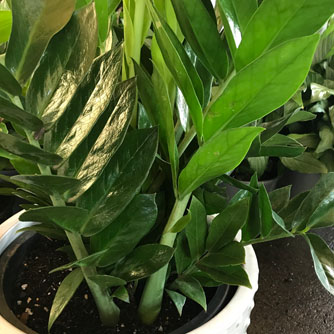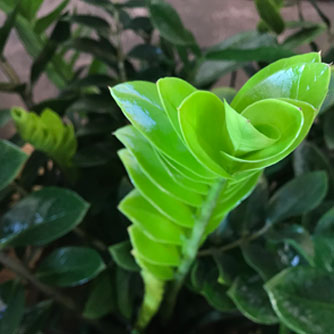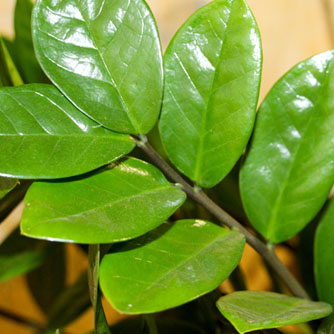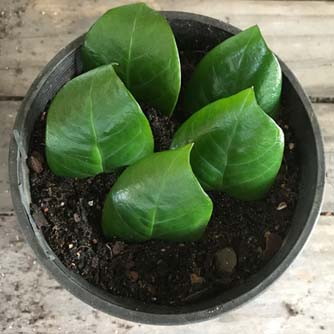Zamioculcas (aka as ZZ plant or Zanzibar Gem)
BackZamioculcas is an amazing indoor plant but it’s name is certainly a bit tricky. In fact it’s full botanical name is Zamioculcas zamiifolia so how’s that for a mouthful? Some people shorten it the ZZ plant but whatever you call it it’s worth growing because this indoor plant will survive in low light with little water and zero attention. Just perfect if you’re a little rough on your indoor plants!
Zamioculcas is a tropical succulent with thick glossy leaves that comes from eastern Africa. It can produce a flower spathe at the base of the plant but they really aren’t that interesting. The best known variety is called ‘Zanzibar Gem’ and it has lovely rich green leaves. There’s also a variety with almost black leaves which has been recently released in Australia.
As mentioned above they make the perfect indoor plant but in warmer locations they also look great as understory plantings in tropical style gardens.

Zamioculcas produce lovely rich green foliage
How To Grow Zamioculcas
As an indoor plant it’s best to position them in a spot which receives bright light but not direct sunlight. Yes they can survive in low light conditions but give them more light and they’ll really thrive. As a tropical plant they also need a bit of protection from cold draughts.
Zamioculcas can be grown outdoors if temperatures don’t drop below 15 degrees. Again bright light is best and avoid hot direct sunlight on them.
Wherever you grow them it’s important that the soil has good drainage. In pots use a cactus and succulent mix or make your own by adding sand and perlite to a regular potting mix. Either way don’t let the plant sit in water as they can rot quite easily.
Now these plants can go a long time without a drink BUT if you want them to look their best they do need watering. The trick is to not overwater as this can cause them to rot away. Confused? Well here’s how to get it right:
- Make sure they’re growing in free draining soil so the soil doesn’t stay wet around their roots for very long. Also don’t let water pool in the saucer.
- As a general guide water when the top few centimetres of soil feels dry. During warm periods this could be as often as weekly but in colder conditions (like winter) it’s more likely to be monthly. When it’s warm they’ll be actively growing and use more water but during colder times they’re inactive and need much less.

New shoots are initially light green but darken over time
Note that long periods without water (like several months) can send them into dormancy where they drop their leaves and may appear to be dying. If this happens give them a water and new shoots will develop from the rhizomes. Just don’t leave it quite so long between drinks next time
Fertilising and Maintenance of Zamioculcas
Normally people think zamioculcas are slow growing plants but if given warmth and water (with good drainage) then they’ll remain in growth mode and grow quite nicely. As such they’ll appreciate being fed every 2 weeks with a mix of OCP eco-seaweed and OCP eco-aminogro. During winter you can cut back to just once a month.
A large plant can also be easily divided by cutting up the root ball into smaller clumps of rhizomes. Plant into fresh potting mix and water in with OCP eco-seaweed. This is best done during the warmer times of the year when plants are actively growing and will recover faster.
Plants can be propagated by using a long leaf cutting or more commonly by breaking off individual leaflets. Simply stick the cutting or leaflets into cacti and succulent potting mix, water lightly and then cover with a clear plastic bag. Place in a warm, brightly lit spot (not direct sun) to encourage faster root development. This can take 9-12 months so be patient.

Individual leaflets can be broken off to propagate new zamioculcas plants
Pests and Disease Problems of Zamioculcas
These are really tough plants with few concerns. The only problems you may encounter are:
- Rotting at the base due to overwatering. Check the soil drainage and reduce your watering regime. Apply OCP eco-seaweed to help stressed plants recover quickly.
- Mealybugs may appear but can be controlled with OCP eco-oil or OCP eco-neem.
- Watch for scale and treat with an organic insecticide.

Zamioculcas cuttings ready to be covered with a clear plastic bag


